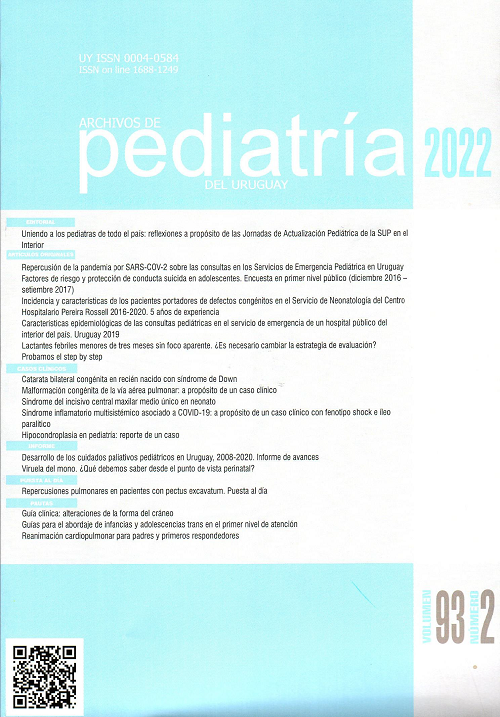Abstract
Introduction: fever is a very frequent reason for consultation and in up to 20% of patients the cause has not been found. In the field of pediatric emergentology, there has been a traditional interest in homogenizing the way of assessing febrile infants under three months of age. Having a protocol that enables early detection of children with IBIs without engaging in disproportionate procedures is a challenge.
Objective: to evaluate and compare the ability to identify IBIs in the present FSF regimen as in the Step-by-Step strategy, in infants with FSF assessed at the Pereira Rossell Pediatric Hospital Center.
Material and methods: observational, descriptive, retrospective study and diagnostic tests. Inclusion criteria: Infants under 90 days of age who consulted in 2017 and 2018 at the DEP-CHPR with a diagnosis of FSF.
Results: 261 infants diagnosed with FSF regimen were included and they all received a Step-by-Step approach. The age range was 84 days (4 - 88) days with a mean of 41 days. Males 148 children (56.7%). There were 37 bacterial infections (14.2%), of which 3 were IBI (1.1%) and 34 were Non-IBI (13.1%). The sensitivity for the Step-by-Step approach was 0.94% and 0.89 for the current regimen, with a NPV of 0.98 for both strategies.
Discussion: infants younger than 3 months-old are more susceptible due to physiological characteristics to invasive bacterial infections, and the younger they are, the higher the frequency. The Step-by-Step Approach splits children of under 1 month of age into those under or over 21 days of age. Our guideline does not make this discrimination and performs the same blood, urine and cerebrospinal fluid laboratory tests sometimes carrying out blood tests is not necessary.
Conclusions: both approaches used in this population were highly sensitive to the identification of bacterial infections with a high NPV. The application of the “Step-by-Step” approach has the additional benefit of avoiding lumbar puncture to newborns of between 21 and 28 days of age.

This work is licensed under a Creative Commons Attribution 4.0 International License.
Copyright (c) 2022 Manuel Dávila, Patricia Dall´Orso, Mónica Pujadas, Javier Prego

